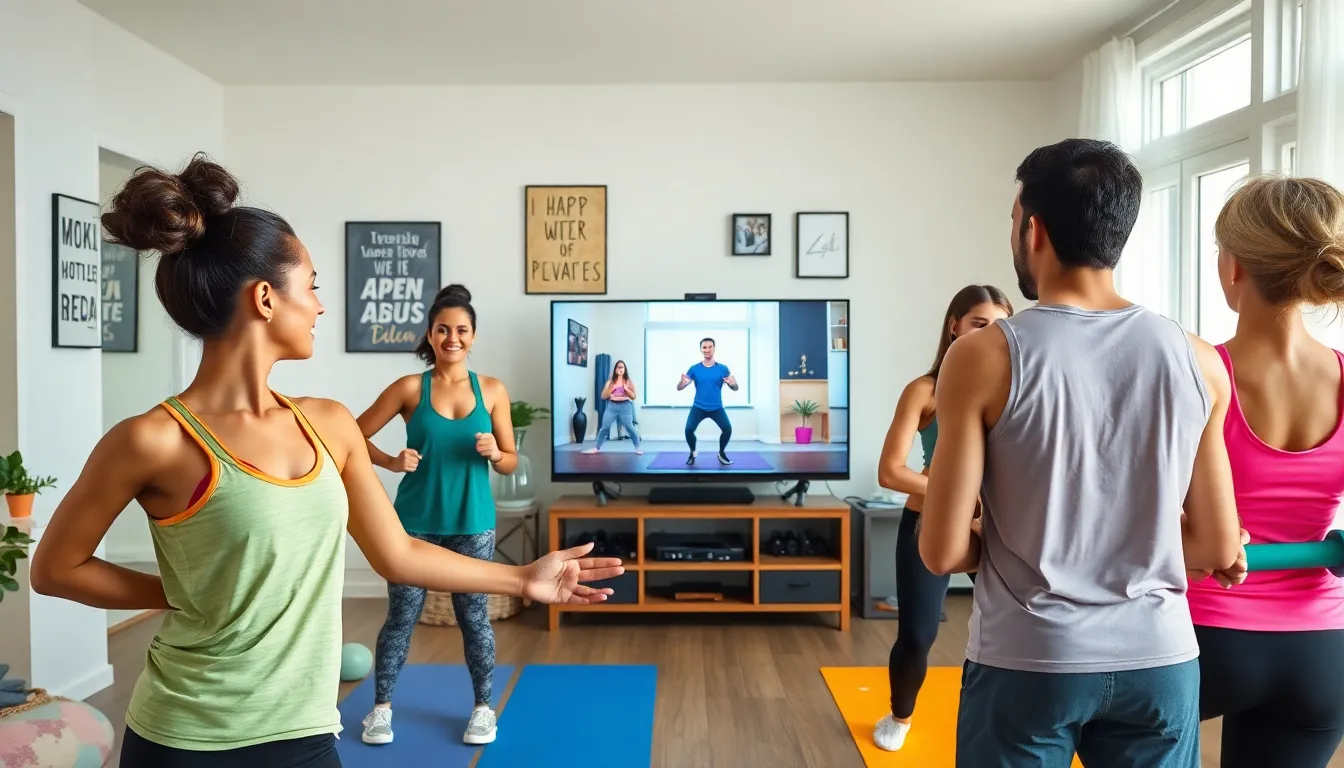In a world where convenience meets wellness, virtual fitness classes have emerged as a game-changer. With just a click, individuals can access a variety of workouts from the comfort of their homes, eliminating barriers like travel time and gym memberships. This shift not only caters to busy lifestyles but also opens up a diverse range of fitness options that appeal to all levels.
As people increasingly seek flexibility and personalization in their fitness journeys, virtual classes offer tailored experiences that traditional gyms often can’t match. Whether it’s yoga, high-intensity interval training, or dance, the online fitness landscape provides something for everyone. This article explores the benefits of virtual fitness classes and how they can transform one’s approach to health and exercise.
Table of Contents
ToggleOverview Of Virtual Fitness Classes
Virtual fitness classes provide a versatile platform for individuals seeking effective workout solutions. These classes typically take place in real-time or via pre-recorded sessions, accommodating various schedules and preferences.
Key Features
- Accessibility: Virtual classes remove geographic barriers, allowing access from any location with internet connectivity. This increases participation among individuals who may not attend in-person sessions.
- Variety: Options encompass a wide range of disciplines such as yoga, Pilates, kickboxing, and strength training. Users can select classes based on their interests and skill levels.
- Personalization: Many platforms offer tailored workout plans. Ratings and feedback often guide users in finding classes that suit their fitness goals and preferences.
- Cost-Effectiveness: Compared to traditional gym memberships, virtual classes usually present lower costs or subscription models, making fitness more economical.
- Flexibility: Users can choose when and where to participate. This flexibility suits those balancing work, family, or other commitments, enabling consistent exercise habits.
Popular Platforms
| Platform Name | Class Types | Pricing Model |
|---|---|---|
| Peloton | Cycling, strength, yoga | Subscription-Based |
| Beachbody On Demand | HIIT, dance, nutrition coaching | Subscription-Based |
| Zwift | Cycling, running | Subscription-Based |
| YouTube (Various Channels) | Free workouts, diverse formats | Free |
| ClassPass | Various classes at local studios | Membership-Based |
Virtual fitness classes enhance engagement through community features like chat functions and leaderboards. This social aspect motivates participants and fosters accountability.
Benefits Of Virtual Fitness Classes

Virtual fitness classes offer numerous advantages that enhance workout experiences, making them a viable option for many individuals.
Convenience And Flexibility
Convenience and flexibility are primary benefits of virtual fitness classes. Participants access classes from any location, allowing them to integrate workouts into busy schedules. Classes occur at various times, catering to diverse time zones and preferences. Users can join live sessions or choose pre-recorded workouts, enabling them to exercise whenever it fits their lifestyle. Many platforms also offer features such as adjustable workout intensity, accommodating different fitness levels and goals.
Accessibility For All
Accessibility for all is a notable advantage of virtual fitness classes. Individuals no longer face geographical restrictions or significant costs associated with traditional gyms. Those in remote areas still access high-quality instruction and diverse workout options. Many virtual classes provide options for various fitness levels, making fitness approachable for beginners and advanced athletes alike. Furthermore, many platforms offer free or low-cost trial sessions, allowing users to explore options before committing financially.
Types Of Virtual Fitness Classes
Virtual fitness classes come in various formats, catering to different preferences and schedules. Two primary types include live streaming options and on-demand classes.
Live Streaming Options
Live streaming options allow participants to engage in real-time classes led by certified instructors. These classes foster community interaction through chat functionalities, enabling participants to ask questions and receive immediate feedback. Scheduled sessions accommodate diverse time zones, offering choices throughout the day. Popular formats include yoga, Zumba, and cycling, providing a dynamic workout experience. Some platforms utilize high-definition video and audio technology to enhance the overall experience, ensuring clear visibility and instruction during the workouts.
On-Demand Classes
On-demand classes provide flexibility by allowing users to select workouts based on their schedules. Users can access a vast library of fitness sessions, ranging from 10 to 60 minutes in length, across various disciplines like Pilates, strength training, and martial arts. Participants can filter classes by difficulty level, workout type, or duration to match their preferences and needs. This format encourages self-paced fitness, letting individuals revisit favorite classes or try new workouts whenever convenient. Platforms frequently update their libraries, ensuring fresh content and keeping users engaged with new challenges.
Popular Platforms For Virtual Fitness Classes
Numerous platforms provide virtual fitness classes, catering to various preferences and budgets. These platforms offer both subscription services and free resources to meet the diverse needs of users.
Subscription Services
Subscription services deliver high-quality fitness content through a monthly or yearly fee. Popular options include:
- Peloton: Offers access to live and on-demand cycling, strength, and stretching classes with interactive features.
- Beachbody On Demand: Features popular fitness programs like P90X and Insanity, along with meal plans tailored to users’ goals.
- YogaGlo: Provides unlimited access to yoga and meditation sessions for all levels, focusing on mindfulness in addition to physicality.
- FightCamp: Specializes in boxing and kickboxing workouts, offering equipment packages for a comprehensive training experience.
- Les Mills On Demand: Brings high-energy classes, including BodyPump and BodyCombat, directly to users’ homes with engaging instructors.
These services typically provide free trial periods, allowing users to explore the content before committing.
Free Resources
Free resources offer an accessible entry point for individuals seeking virtual fitness. Notable platforms include:
- YouTube: Hosts a vast array of fitness channels, featuring instructors who cover various workouts, from dance to high-intensity training.
- Fitness Blender: Provides free video workouts along with meal planning and fitness tips, catering to a wide audience.
- Nike Training Club: Offers a free app with bodyweight workouts and training plans designed by renowned trainers.
- Darebee: Features hundreds of no-equipment workouts, challenges, and fitness programs available as downloadable PDFs.
These free options enable individuals to engage in fitness without financial burden, encouraging participation in diverse workout formats.
Virtual fitness classes have revolutionized the way people approach their health and wellness. By offering a diverse range of workouts that cater to various preferences and fitness levels, these classes make exercise more accessible than ever. The convenience of participating from home or any location removes traditional barriers, allowing individuals to fit fitness into their busy schedules.
As technology continues to advance, the popularity of virtual classes is likely to grow. With options available for every budget and the ability to engage with instructors and fellow participants in real-time, it’s clear that virtual fitness is here to stay. Embracing this trend can lead to healthier lifestyles and a more enjoyable fitness journey.


